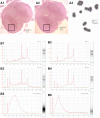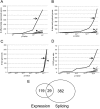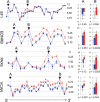Sporadic ALS has compartment-specific aberrant exon splicing and altered cell-matrix adhesion biology
- PMID: 19864493
- PMCID: PMC2796893
- DOI: 10.1093/hmg/ddp498
Sporadic ALS has compartment-specific aberrant exon splicing and altered cell-matrix adhesion biology
Abstract
Amyotrophic lateral sclerosis (ALS) is a fatal neurodegenerative disease characterized by progressive weakness from loss of motor neurons. The fundamental pathogenic mechanisms are unknown and recent evidence is implicating a significant role for abnormal exon splicing and RNA processing. Using new comprehensive genomic technologies, we studied exon splicing directly in 12 sporadic ALS and 10 control lumbar spinal cords acquired by a rapid autopsy system that processed nervous systems specifically for genomic studies. ALS patients had rostral onset and caudally advancing disease and abundant residual motor neurons in this region. We created two RNA pools, one from motor neurons collected by laser capture microdissection and one from the surrounding anterior horns. From each, we isolated RNA, amplified mRNA, profiled whole-genome exon splicing, and applied advanced bioinformatics. We employed rigorous quality control measures at all steps and validated findings by qPCR. In the motor neuron enriched mRNA pool, we found two distinct cohorts of mRNA signals, most of which were up-regulated: 148 differentially expressed genes (P <or= 10(-3)) and 411 aberrantly spliced genes (P <or= 10(-5)). The aberrantly spliced genes were highly enriched in cell adhesion (P <or= 10(-57)), especially cell-matrix as opposed to cell-cell adhesion. Most of the enriching genes encode transmembrane or secreted as opposed to nuclear or cytoplasmic proteins. The differentially expressed genes were not biologically enriched. In the anterior horn enriched mRNA pool, we could not clearly identify mRNA signals or biological enrichment. These findings, perturbed and up-regulated cell-matrix adhesion, suggest possible mechanisms for the contiguously progressive nature of motor neuron degeneration. Data deposition: GeneChip raw data (CEL-files) have been deposited for public access in the Gene Expression Omnibus (GEO), www.ncbi.nlm.nih.gov/geo, accession number GSE18920.
Figures




Similar articles
-
Loss of nuclear TDP-43 in amyotrophic lateral sclerosis (ALS) causes altered expression of splicing machinery and widespread dysregulation of RNA splicing in motor neurones.Neuropathol Appl Neurobiol. 2014 Oct;40(6):670-85. doi: 10.1111/nan.12148. Neuropathol Appl Neurobiol. 2014. PMID: 24750229
-
Motor neurons from ALS patients with mutations in C9ORF72 and SOD1 exhibit distinct transcriptional landscapes.Hum Mol Genet. 2019 Aug 15;28(16):2799-2810. doi: 10.1093/hmg/ddz104. Hum Mol Genet. 2019. PMID: 31107959 Free PMC article.
-
RNA-seq analyses reveal that cervical spinal cords and anterior motor neurons from amyotrophic lateral sclerosis subjects show reduced expression of mitochondrial DNA-encoded respiratory genes, and rhTFAM may correct this respiratory deficiency.Brain Res. 2017 Jul 15;1667:74-83. doi: 10.1016/j.brainres.2017.05.010. Epub 2017 May 13. Brain Res. 2017. PMID: 28511992
-
[Gene expression profile of spinal ventral horn in ALS].Brain Nerve. 2007 Oct;59(10):1129-39. Brain Nerve. 2007. PMID: 17969353 Review. Japanese.
-
The role of RNA processing in the pathogenesis of motor neuron degeneration.Expert Rev Mol Med. 2010 Jul 20;12:e21. doi: 10.1017/S1462399410001523. Expert Rev Mol Med. 2010. PMID: 20642879 Review.
Cited by
-
Proteomic analysis of cerebrospinal fluid of amyotrophic lateral sclerosis patients in the presence of autologous bone marrow derived mesenchymal stem cells.Stem Cell Res Ther. 2024 Sep 15;15(1):301. doi: 10.1186/s13287-024-03820-2. Stem Cell Res Ther. 2024. PMID: 39278909 Free PMC article. Clinical Trial.
-
Aberrant NOVA1 function disrupts alternative splicing in early stages of amyotrophic lateral sclerosis.Acta Neuropathol. 2022 Sep;144(3):413-435. doi: 10.1007/s00401-022-02450-3. Epub 2022 Jul 1. Acta Neuropathol. 2022. PMID: 35778567 Free PMC article.
-
Drosophila lines with mutant and wild type human TDP-43 replacing the endogenous gene reveals phosphorylation and ubiquitination in mutant lines in the absence of viability or lifespan defects.PLoS One. 2017 Jul 7;12(7):e0180828. doi: 10.1371/journal.pone.0180828. eCollection 2017. PLoS One. 2017. PMID: 28686708 Free PMC article.
-
LSD1 protects against hippocampal and cortical neurodegeneration.Nat Commun. 2017 Oct 9;8(1):805. doi: 10.1038/s41467-017-00922-9. Nat Commun. 2017. PMID: 28993646 Free PMC article.
-
Understanding the role of TDP-43 and FUS/TLS in ALS and beyond.Curr Opin Neurobiol. 2011 Dec;21(6):904-19. doi: 10.1016/j.conb.2011.05.029. Epub 2011 Aug 2. Curr Opin Neurobiol. 2011. PMID: 21813273 Free PMC article. Review.
References
-
- Rowland L.P., Shneider N.A. Amyotrophic lateral sclerosis. N. Engl. J. Med. 2001;344:1688–1700. - PubMed
-
- Bruijn L.I., Miller T.M., Cleveland D.W. Unraveling the mechanisms involved in motor neuron degeneration in ALS. Annu. Rev. Neurosci. 2004;27:723–749. - PubMed
-
- Boillee S., Vande Velde C., Cleveland D.W. ALS: a disease of motor neurons and their nonneuronal neighbors. Neuron. 2006;52:39–59. - PubMed
-
- Neusch C., Bähr M., Schneider-Gold C. Glia cells in amyotrophic lateral sclerosis: new clues to understanding an old disease? Muscle Nerve. 2007;35:712–724. - PubMed
Publication types
MeSH terms
Associated data
- Actions
Grants and funding
LinkOut - more resources
Full Text Sources
Other Literature Sources
Medical
Molecular Biology Databases
Miscellaneous

